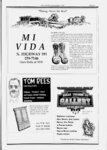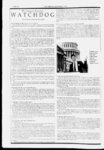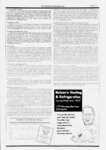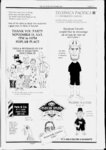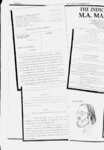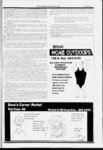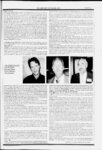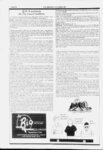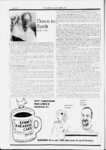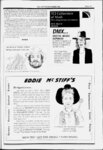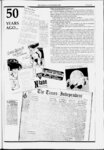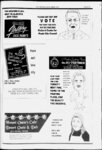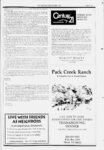| OCR Text |
Show 4 ' I Then after slapping Emily and creating a scene, the former girlfriend ran to federal ." The feds guickly threw John into jail for the crime. Finding agent him guilty the court sentenced him to five years in the pen and a fine of $100 he the sentence, John was cheated out of the chance to help establish Though appealed the great "shortcut" through the canyons and to colonize southeast Utah (and as a footnote, John's new English wife ran off with one of the U.S. deputies assigned to the ' j ' have heard Charlie's son. Hardy, talk often about stewardship. I think this philosophy runs in the family. Arrington notes that Charlie held that "property rights should be administered under the principle of stewardship." And he notes the Mormon doctrine: must subdue the earth and make it teem with living plants and animals. Men must assist God in the process of redeeming the earth and making it a fitting abode for God's people. The earth must be turned into a Garden of Eden." "Men case.) John had to be content on seeing other of his kin make the journey. This included connections with the Sevy, Pace, Stevens, Perkins and other families of this historic party. And after settlement, even more of the Spencer family were to drift to the San Juan country. In this regard, Emily Washburn, from the Spencer line, married Charlie Redd's first cousin. Over 200 people, 83 wagons, each with two or more teams of horses, about 200 additional horses, and more than a thousand head of cattle were involved in the winter of 1879-8I itself is the most singly significant part of the entire suppose the trail. Here the construction of the passageway to the river was extremely difficult. Picks and blasting powder were usai to widen the crevice. A road, named "Uncle Ben's dugway," was built on the side of a sheer cliff wall. Stakes were driven into the rock and vegetation, rocks, and sand were piled on top of that. Six weeks were spent here. d They journeyed over 290 miles, much of it through canyon country, The winter journey lasted six months, rather than six weeks, averaging out maybe 1 .7 miles per day. Arriving finally at the present site of Bluff, the exhausted and spent party decided to stop and make their settlement. The site was good enough. 7 i i I , He quotes Brigham Young: "Men shall be stewards over that which they possess." And he repeats another Mormon saying: "The earth is the Lord's." Charlie Redd and his wife, Annalcy, accomplished a great deal. One of their greatest accomplishments must surely be noted. In 1972 they established the Lemuel H. Redd Chair in Western History and the Charles Redd Center for Western Studies at Brigham Young University. The Center has been extremely successful and much good has come from it. Charlie Redd died in 1975 in his eighty-sixt- h year. I wish that I had met him when I had the He left a opportunity. great legacy. 0. Hole-in-the-Ro- ck ; - 21 I "polyg-hunters- i PAGE THE ZEPHYRNOVEMBER 1995 steep-gorge- j, trail My interest in Glen Canyon, the Escalante Canyon and the to me move the of Escalante in of to town heart the This the inspired canyon country. I did by uprooting my wife and children from Bountiful after giving them good reasons they should be uprooted. In Escalante I met relatives that I had never known. My grandmother herself had once lived in Escalante when her father, John Home Miles, moved there to teach after his appeal to the U.S. Supreme Court had been heard and his case dismissed (he took no further wives). Now that we have rambled on through history, let us turn our attention to the Redds' treatment and philosophy concerning the environment. settlers arrived in Arrington notes in his book that when the Bluff in the spring of 1880, the range had already been heavily grazed. In the late 70's and early 80's thousands of cattle from Texas and other western states arrived in the canyon country to feed on the free grass. There came a race to "use up the grass before someone else got to it." Sheep were introduced in the 1890's, and along with the cattle, the rangelands were being destroyed. The Redds acknowledge that. Charlie Redd, noting the deteriorating ranges, struggled to reclaim the range lands. Building hundreds of miles of fences, he concentrated his cattle in areas in which he wanted them concentrated. He built stock water holes and troughs, range trails, and seeded thousands of acres of range land. He ripped out many acres of sagebrush, juniper and pinyon pine and planted crested wheatgrass in their place. Arrington reports that good grass stands were obtained and the watershed was greatly improved. 1 don't agree with all of the measures taken by Charlie Redd, under today's conditions (chaining for one), however in this book we arc looking through the eyes of a very successful rancher stockman who came to really know his business. And he learned it welL This book portrays five generations of land management through the eyes of the Redd family. This book, though very enlightening, has not changed the way I myself view land management. In my opinion, certain grazing lands can be successfully managed by responsible ranchers without greatly damaging the resources. I have no problem with zoning certain lands for proper grazing practices, just as I have no problem in setting aside wilderness areas for other purposes. The point is that we each must manage lands the very best we can. We cannot afford to destroy the very things on which we arc dependent or those things we hold of great value. Hole-in-the-Ro- , Hole-in-the-Ro- ck 702 S. Main BLUE WARE i 259-573- 1 DUTCH OVENS ck WATERBAGS SLEEPING BAGS CAMP GEAR LITTLE-KNOW- N FACTS FROM MOAB OUTDOORS: j I If turkeys exercised regularly and ate the right foods, they wouldn't get fat and we wouldn't i eat them. i EfcEdfeGEoGH? JtfiEaSt; CreekDriveV259-- 6 99,9 HERE AT DAVES, WE CARE IT'S THE ONLY THING, ABOUT THE HEALTH OF IN OUR CUSTOMERS. SOME OF OUR BEST THAVS WHY WE SELL FACT, THAT KEEPS CUSTOMERS ALIVE. 'BE WELL,' A LITTLE DRINK THAT HAS EVERYTHING YOU NEED FOR A HEALTHY BODY. MORE 'BE WELL.' AND HURRY. |








